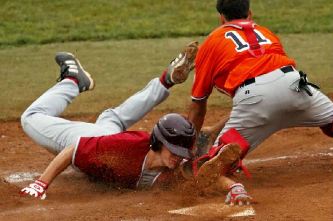

The winter sports season is in full swing, and spring sports are a ways off, but safety comes first, no matter what the sport or the season.
"Every team and athlete should have sports safety as a top priority," says Larry Cooper, chair of the National Athletic Trainers' Association Secondary School Committee and head athletic trainer at Penn Trafford (Pa.) High School. "It's vital for coaches, athletic trainers, parents and the athletes themselves to maintain good communication and follow guidelines to ensure all participants are fit for play."
In March, the NATA will be hosteing its 5th Youth Sports Safety Summit with the support of the Youth Sports Safety Alliance [1], now composed of more than 100 organizations, including MomsTEAM, committed to keeping athletes safe. Last year, the NATA launched the first-ever National Action Plan for Sports Safety [2] and issued a Student Athlete Bill of Rights [3]. "Each athlete is entitled to appropriate care, prevention and treatment of injuries should they occur," says Cooper.

Here is a sixteen-point sports safety checklist to keep athletes in the game. How many is your child's program following?
"It's critical that all members of a school's athletic health care team, parents, teachers and others involved in the care of the athlete have ongoing communication to ensure a safe sports setting," says Cooper. "With those protocols in place, athletes can enjoy the great spirit, competition, and accomplishment that come from safe and fair play."
"And, if your school is following the right protocols, enter it in the NATA Safe School award program [40] that recognizes schools implementing appropriate steps to keep athletes safe. It is a win-win for students, the athletic health care team and school at large."
Sources: National Athletic Trainers' Association, MomsTEAM.com

Links:
[1] http://www.youthsportssafetyalliance.org
[2] https://momsteam.com/node/5792
[3] http://www.youthsportssafetyalliance.org/docs/Athletes-Bill-of-Rights.pdf
[4] https://momsteam.com/node/2581
[5] https://momsteam.com/node/2025
[6] https://momsteam.com/node/2579
[7] https://momsteam.com/node/190
[8] https://momsteam.com/node/2697
[9] https://momsteam.com/node/276
[10] https://momsteam.com/node/2446
[11] https://momsteam.com/node/2987
[12] https://momsteam.com/node/149
[13] https://momsteam.com/node/4029
[14] https://momsteam.com/node/203
[15] https://momsteam.com/node/801
[16] https://momsteam.com/node/221
[17] https://momsteam.com/node/128
[18] https://momsteam.com/node/2700
[19] https://momsteam.com/node/371
[20] https://momsteam.com/node/388
[21] https://momsteam.com/node/389
[22] https://momsteam.com/node/6067
[23] https://momsteam.com/node/535
[24] https://momsteam.com/node/293
[25] https://momsteam.com/node/2672
[26] https://momsteam.com/node/763
[27] https://momsteam.com/node/1452
[28] https://momsteam.com/node/384
[29] https://momsteam.com/node/800
[30] https://momsteam.com/node/312
[31] https://momsteam.com/node/3121
[32] https://momsteam.com/node/3074
[33] https://momsteam.com/node/798
[34] https://momsteam.com/node/5110
[35] https://momsteam.com/node/2021
[36] https://momsteam.com/node/3343
[37] https://momsteam.com/node/2876
[38] https://momsteam.com/node/596
[39] https://momsteam.com/node/2054
[40] https://momsteam.com/node/6009
[41] https://momsteam.com/nata-youth-sports-safety-alliance-adopts-first-national-action-plan-for-youth-sports-safety
[42] https://momsteam.com/health-safety/general-safety/emergency-medical-plan-essential-for-youth-sports-safety
[43] https://momsteam.com/calling-time-out-before-sports-helps-ensure-player-safety-athletic-trainer-group-says
[44] https://momsteam.com/health-safety/general-safety/injury-prevention/youth-sports-organizations-need-bad-weather-policies
[45] https://momsteam.com/health-safety/cardiac-safety/general/chain-of-survival-for-sudden-cardiac-arrest
[46] https://momsteam.com/team-of-experts/pre-participation-evaluations-a-primer-for-parents
[47] https://momsteam.com/health-safety/general-safety/injury-prevention/athletic-fields-are-an-overlooked-safety-hazard
[48] https://momsteam.com/health-safety/athletic-health-care-teams-many-component-parts
[49] https://momsteam.com/team-of-experts/athletic-trainer-AT-every-school-should-have-one
[50] https://momsteam.com/health-safety/exertional-sickling-life-threatening-condition-for-youth-with-sickle-cell-trait
[51] https://momsteam.com/health-safety/management-of-asthma-in-sports
[52] https://momsteam.com/background-checks/annual-background-checks-for-all-adults-in-youth-sports-with-no-exceptions
[53] https://momsteam.com/mrsa/mrsa-skin-infections-frequently-asked-questions
[54] https://momsteam.com/sports/honest-self-reporting-concussions-symptoms-critical-for-athletes